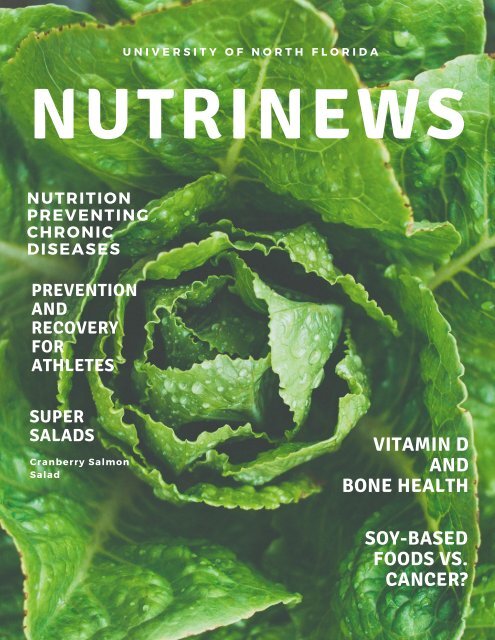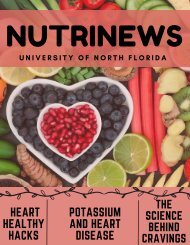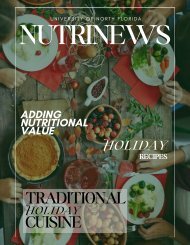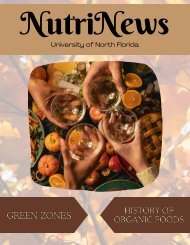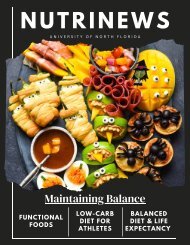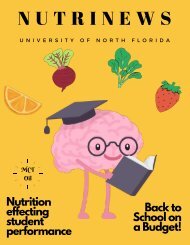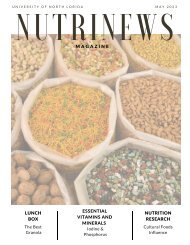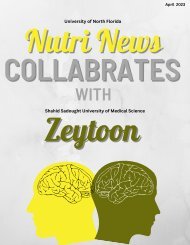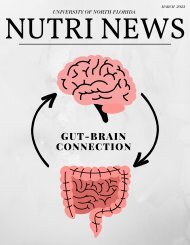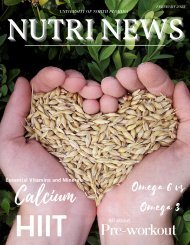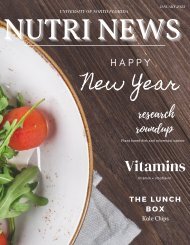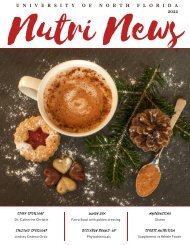Nutrinews
Nutrition plays a significant role in the prevention of various diseases, illnesses, and chronic conditions. This issue of NutriNews discusses how much of an impact our dietary patterns can have. Throughout the issue you can find research that shows the links between diet and prevention, delicious recipes, and much more!
Nutrition plays a significant role in the prevention of various diseases, illnesses, and chronic conditions. This issue of NutriNews discusses how much of an impact our dietary patterns can have. Throughout the issue you can find research that shows the links between diet and prevention, delicious recipes, and much more!
Create successful ePaper yourself
Turn your PDF publications into a flip-book with our unique Google optimized e-Paper software.
U N I V E R S I T Y O F N O R T H F L O R I D A<br />
NUTRINEWS<br />
NUTRITION<br />
PREVENTING<br />
CHRONIC<br />
DISEASES<br />
PREVENTION<br />
AND<br />
RECOVERY<br />
FOR<br />
ATHLETES<br />
SUPER<br />
SALADS<br />
Cranberry Salmon<br />
Salad<br />
VITAMIN D<br />
AND<br />
BONE HEALTH<br />
SOY-BASED<br />
FOODS VS.<br />
CANCER?
TABLE OF CONTENTS<br />
“ L U C K I S W H A T H A P P E N S W H E N<br />
P R E P A R A T I O N M E E T S O P P U R T U N I T Y . ”<br />
-Seneca<br />
NUTRITION RESEARCH<br />
Nutrition for Preventing Chronic Diseases<br />
04<br />
MYTH BUSTING<br />
Do Soy-Based foods Cure Cancer? 10<br />
LUNCH BOX<br />
Cranberry Salmon Salad<br />
14<br />
SPORTS NUTRITION<br />
Nutrition for Preventing and Recovery Among Athletes 17<br />
MONTHLY HACKS<br />
Tips to Decrease Diseases/ Illnesses<br />
22<br />
SPOTLIGHT<br />
Meals on Wings and Chef Meghan 24<br />
VITAMINS AND MINERALS<br />
Link Between Vitamin D and Bone Health<br />
26<br />
MEET THE TEAM<br />
Get To Know Our Staff!! 28
Nutrition Research<br />
NUTRITION FOR THE PREVENTION OF<br />
CHRONIC<br />
DISEASES<br />
By: Tavianna Brooks<br />
Prevention measures are important<br />
in decreasing the risk of developing<br />
chronic disease. According to the<br />
Centers for Disease Control and<br />
Prevention (CDC), chronic disease is<br />
a broad term that encompasses<br />
conditions that last a year or more.<br />
Requiring continuous medical<br />
attention and/or limiting daily<br />
living.1<br />
Six out of ten Americans will develop<br />
at least one chronic disease (CDC),<br />
such as heart disease, stroke, or type 2<br />
diabetes.2 However, lifestyle factors<br />
like adequate nutrition are a<br />
preventative measures to fight against<br />
chronic disease.1,3 For example,<br />
insufficient vitamin K impacts blood<br />
coagulation, insufficient vitamin D<br />
and/or calcium impacts bone<br />
development and maintenance.4<br />
4
To prevent chronic disease, the CDC urges<br />
people to consume an array of colors in<br />
their diet, such as dark leafy greens,<br />
oranges, and tomatoes.5 A diet containing<br />
whole grains, milk products, and various<br />
protein sources is also important.5<br />
Additionally, it's recommended to reduce<br />
salt, sugar, saturated fats, and trans fats.5<br />
Pasdar et al. conducted a cross-sectional<br />
study that concluded dietary patterns rich<br />
in fiber, vitamins, and polyphenols reduce<br />
the atherosclerotic burden. This is “caused<br />
by atherogenic lipoproteins, and thus<br />
reduces the risk of cardiovascular<br />
diseases”.6 Plant-based, Mediterranean,<br />
and DASH diets are dietary patterns<br />
associated with antioxidant and<br />
inflammatory properties.6 Pasdar et al. also<br />
noted that its cross-sectional design<br />
“cannot show a causal relationship<br />
between the dietary inflammatory index<br />
and dyslipidemia.”6<br />
5
A randomized control trial by<br />
Podadero-Herreros et al.<br />
investigated Mediterranean and lowfat<br />
diets for the prevention and<br />
development of chronic kidney<br />
disease in patients with coronary<br />
heart disease (and/or some patients<br />
with type 2 diabetes).7 The<br />
Mediterranean macronutrient<br />
composition was 35% fat, 22%<br />
MUFA, and less than 50%<br />
carbohydrates. Versus the low-fat<br />
diet, which had 28% fat, 12% MUFA,<br />
and more than 55% carbohydrates.7<br />
Kidney performance was assessed by<br />
the estimated glomerular filtration<br />
rate (eGFR).7 Although eGFR<br />
decreased with both diets, the<br />
Mediterranean diet intervention<br />
resulted in a slower decrease<br />
compared to the low-fat diet.7 There<br />
were no significant differences in<br />
non-diabetic patients; the effect was<br />
mainly present in patients with an<br />
already impaired eGFR.7<br />
6<br />
In a similar study, Jimenez-Torres et al.<br />
investigated Mediterranean and low-fat diets to<br />
prevent atherosclerosis.8 Results reveal that<br />
patients in both diet interventions had reduced<br />
plasma saturated fatty acid levels with little<br />
difference.8 Compared to a low-fat diet, longterm<br />
adherence to a Mediterranean diet rich in<br />
extra virgin olive oil “was associated with<br />
decreased atherosclerosis progression.”8 Both<br />
diet interventions increased total plasma MUFA<br />
levels, but “the Mediterranean diet produced a<br />
higher increase in MUFA”.8 However, the lowfat<br />
diet significantly increased total PUFAs<br />
compared to the Mediterranean diet.8<br />
Researchers noted that anti-inflammatory and<br />
endothelial injuries decreased as a result of<br />
these diets.8
A two-year randomized control trial<br />
conducted in Finland by Ngandu et al.<br />
aimed to prevent cognitive decline in a<br />
vulnerable elderly population.9 Cognitive<br />
screening, such as word-list memory<br />
tasks, was performed throughout the<br />
study.9 The nutritional intervention was a<br />
diet with “10–20% of daily energy from<br />
proteins, 25–35% daily energy from fat<br />
[least amount from trans fatty acids and<br />
saturated fats], 45–55% daily energy from<br />
carbohydrates [emphasis on whole<br />
grains], 25–35 g/day of dietary fiber,” salt,<br />
and alcohol restriction.9<br />
In addition to exercise, results show a 25-<br />
150% increase in cognition for the<br />
intervention group compared to the<br />
control group.9 A meta-analysis of 104<br />
studies by Kelly et al. identified that<br />
higher potassium and vegetable intake<br />
indicated a decreased risk of chronic<br />
kidney disease.10 Another meta-analysis<br />
study identified that whole grain intake<br />
reduces risk of “coronary heart disease,<br />
cardiovascular disease, and total cancer,<br />
and mortality from all causes, respiratory<br />
diseases, infectious diseases, diabetes,<br />
and all non-cardiovascular diseases”11<br />
References<br />
1. Centers for Disease Control and Prevention. How You Can Prevent Chronic Diseases. CDC. Published October 26, 2023.<br />
https://www.cdc.gov/chronicdisease/about/prevent/index.htm<br />
2. Raghupathi W, Raghupathi V. An empirical study of chronic diseases in the United States: A visual analytics approach to public health. International<br />
Journal of Environmental Research and Public Health. 2018;15(3):1-24. doi:https://doi.org/10.3390/ijerph15030431<br />
3. CDC. About chronic diseases. Centers for Disease Control and Prevention. Published 2022. https://www.cdc.gov/chronicdisease/about/index.htm<br />
4. Gropper SS. The Role of Nutrition in Chronic Disease. Nutrients. 2023;15(3):664. doi:https://doi.org/10.3390/nu15030664<br />
5. Centers for Disease Control and Prevention. Healthy Eating for a Healthy Weight . CDC. Published 2019.<br />
https://www.cdc.gov/healthyweight/healthy_eating/index.html<br />
6. Pasdar Y, Moradi F, Cheshmeh S, et al. Major dietary patterns and dietary inflammatory index in relation to dyslipidemia using cross-sectional results from<br />
the RaNCD cohort study. Scientific Reports. 2023;13(1):19075. doi:https://doi.org/10.1038/s41598-023-46447-8<br />
7. Podadera-Herreros A, Alcala-Diaz JF, Gutierrez-Mariscal FM, et al. Long-term consumption of a mediterranean diet or a low-fat diet on kidney function in<br />
coronary heart disease patients: The CORDIOPREV randomized controlled trial. Clinical Nutrition. 2022;41(2):552-559.<br />
doi:https://doi.org/10.1016/j.clnu.2021.12.041<br />
8. Jimenez-Torres J, Alcalá-Diaz JF, Torres-Peña JD, et al. Mediterranean Diet Reduces Atherosclerosis Progression in Coronary Heart Disease: An Analysis of<br />
the CORDIOPREV Randomized Controlled Trial. Stroke. 2021;52(11):3440-3449. doi:https://doi.org/10.1161/strokeaha.120.033214<br />
9. Ngandu T, Lehtisalo J, Solomon A, et al. A 2 year multidomain intervention of diet, exercise, cognitive training, and vascular risk monitoring versus control to<br />
prevent cognitive decline in at-risk elderly people (FINGER): a randomised controlled trial. Lancet (London, England). 2015;385(9984):2255-2263.<br />
doi:https://doi.org/10.1016/S0140-6736(15)60461-5<br />
10. Kelly JT, Su G, Zhang L, et al. Modifiable Lifestyle Factors for Primary Prevention of CKD: A Systematic Review and Meta-Analysis. Journal of the American<br />
Society of Nephrology : JASN. 2021;32(1):239-253. doi:https://doi.org/10.1681/ASN.2020030384<br />
11. Aune D, Keum N, Giovannucci E, et al. Whole grain consumption and risk of cardiovascular disease, cancer, and all cause and cause specific mortality:<br />
systematic review and dose-response meta-analysis of prospective studies. BMJ. 2016;353(2716):i2716. doi:https://doi.org/10.1136/bmj.i2716<br />
7
March 2024<br />
Myth Busting<br />
Katherine Aljian<br />
DO SOY-BASED<br />
FOODS CAUSE<br />
CANCER?<br />
Addressing Soy Misconceptions,<br />
Compositions, and Body Effects...<br />
In recent years, soy-based foods have received a<br />
bad rap in terms of healthy choices due to rumors<br />
associating it with breast cancer.<br />
Soy-based foods were believed to cause breast<br />
cancer because they contain phytoestrogen, which<br />
is similar to estrogen. (1)<br />
Researchers have linked endogenous estrogen to<br />
the development breast cancer. (1)<br />
More specifically, studies were performed on rats,<br />
which showed evidence that soy could cause cancer.<br />
This study, however, proved to be invalid, since rats<br />
process soy differently than humans. (2)<br />
Soy: Misinterpreted<br />
This misinterpretation resulted in soy-based<br />
products getting a negative spotlight.<br />
An analysis of soy composition and how it affects<br />
the body will put these myths to rest.<br />
10
WHAT IS SOY?<br />
Soy contains many beneficial nutrients, such<br />
as vitamin C and B, fiber, potassium,<br />
magnesium, calcium, iron, and folate. (3,4)<br />
Additionally, soy is high in protein and is<br />
considered a complete protein that contains<br />
nine amino acids that are imperative for<br />
body function. (3) Depending on the soy<br />
product, the health benefits may vary due to<br />
the processing they endure.<br />
“A complete protein that<br />
contains nine amino acids<br />
that are imperative<br />
for body function”<br />
Some soy products contain a lot of nutrients and<br />
proteins. Fermented soy also contains bacteria that<br />
can be beneficial for your gut microbiome.<br />
Examples of fermented soy are miso and natto. Nonfermented<br />
soy includes soy milk, tofu, soybeans,<br />
edamame, soy cheese, and soy burgers. (3)<br />
If you are wondering why soy sauce is not on the list,<br />
it’s because it does not contain a lot of isoflavones<br />
or protein; however, it's great for adding flavor. (3)<br />
11
SOY CONCERNS:<br />
CLARIFIED<br />
On the<br />
Impact<br />
of<br />
Isoflavones<br />
and<br />
Intake...<br />
Isoflavones are the main reason why people stay<br />
away from soy products. Isoflavones are<br />
found in soy and are considered to be a type of<br />
plant estrogen. (2) While high levels of estrogen<br />
are linked to increased risk of breast cancer,<br />
isoflavones block the innate estrogen. (2)<br />
In Japan, a longitudinal study was conducted to<br />
examine correlations between the<br />
consumption of various types of soy and<br />
mortality rates. The study found that fermented<br />
soy products were correlated with a decrease in<br />
cardiovascular disease in men. (5) Further<br />
research Indicated a relationship between high<br />
soy intake throughout life and reduced risk of<br />
breast cancer. If you start eating soy later in life,<br />
however, the benefits won’t be as impactful. (6)<br />
Researchers looking into prostate cancer stated<br />
that elevated consumption of soy milk can<br />
reduce Works Cited the risk of prostate cancer. (7)<br />
1. Nishio K, Niwa Y, Toyoshima H, et al. Consumption of soy foods and the risk of breast<br />
cancer: Findings from the Japan Collaborative Cohort (JACC) study. Cancer Causes<br />
& Control. 2007;18(8):801-808. doi:10.1007/pl00021778<br />
2. Soy and cancer risk: Our expert’s advice. Information and Resources about Cancer: Breast,<br />
Colon, Lung, Prostate, Skin. April 29, 2019. Accessed January 28, 2024.<br />
https://www.cancer.org/cancer/latest-news/soy-and-cancer-risk-our-experts-advice.html.<br />
3. Straight talk about soy. The Nutrition Source. February 2, 2023. Accessed January 28, 2024.<br />
https://www.hsph.harvard.edu/nutritionsource/soy/.<br />
4. Metropulos M. Soy: Types, benefits, and Nutrition. Medical News Today. June 23, 2023.<br />
Accessed January 28, 2024. https://www.medicalnewstoday.com/articles/320472#typesand-uses.<br />
The results of these studies also indicated that<br />
soy has applicable and neutral effects with<br />
decreasing hormonal cancers.<br />
However, the researchers made it clear that<br />
more testing should be done on soy and its<br />
effects on the body.<br />
While the results of the research show that soy<br />
can be helpful in decreasing the likelihood<br />
of hormonal cancer, soy would need to be<br />
ingested at a high rate to see substantial effects<br />
later in life. It was conclusive, however, that soy<br />
does not cause breast cancer and that it is a<br />
great source of proteins and vitamins. Although<br />
more research on soy-based foods is needed, it<br />
has been proven that soy can play a positive role<br />
in preventing disease in the long term and<br />
provide you with fiber and nutrients to help<br />
maintain your health and boost energy levels.<br />
5. Katagiri R, Sawada N, Goto A, et al. Association of soy and fermented soy product intake<br />
with total and cause specific mortality: Prospective cohort study. BMJ. Published online<br />
January 29, 2020:m34. doi:10.1136/bmj.m34<br />
6. Zeratsky K. Truths and myths about the soy-breast cancer link. Mayo Clinic. December 7,<br />
2022. Accessed January 28, 2024. https://www.mayoclinic.org/healthy-lifestyle/nutritionand-healthy-eating/expert-answers/soy-breast-cancer-risk/faq-20120377.<br />
7. Jacobsen, B.K., Knutsen, S.F. & Fraser, G.E. Does high soy milk intake reduce prostate cancer<br />
incidence? The Adventist Health Study (United States). Cancer Causes Control 9, 553–557<br />
(1998). https://doi.org/10.1023/A:1008819500080<br />
12
March 8th 2024<br />
https://www.internationalwomensday.com/Theme#:~:text=The%20campaign%20th<br />
eme%20for%20International,belonging%2C%20relevance%2C%20and%20empow<br />
erment.
The Lunch Box<br />
Cranberry Salmon<br />
Salad<br />
By: Jace Brown<br />
Spring has returned and so has the old gold tide of pollen alongside it. If you’re looking for a meal doused<br />
in color to match its flavor to celebrate the end of our fleeting winter or some extra vitamins to fight off<br />
the pollen wave, cranberry salmon salad solves both dilemmas. It provides an intense pallet both to behold<br />
and taste while incorporating fruit, vegetable, whole grain, and lean protein.<br />
Ingredients:<br />
Croutons:<br />
2 slices of white bread<br />
1 tablespoon of garlic powder<br />
½ tablespoon of salt<br />
3 oz of olive oil<br />
2 oz of parmesan cheese<br />
Salmon:<br />
3 slices salmon filets<br />
8 oz of cranberry sauce<br />
2 oz olive oil<br />
½ teaspoon of garlic powder<br />
½ teaspoon of pepper<br />
Salad:<br />
7 oz romaine lettuce<br />
½ a medium cucumber<br />
½ a red onion<br />
½ tablespoon of lemon juice<br />
Recipe:<br />
1. Crumble whole wheat bread on a pan. Season with garlic<br />
powder, salt, olive oil and parmesan cheese<br />
2. Bake bread un1l crunchy<br />
3. Marinate salmon filets in cranberry sauce for 20 minutes.<br />
(Sauce can be store bought or homemade)<br />
4. Place 2 ounces of olive oil into a frying pan and add the<br />
salmon. Cook until the fish is flaky.<br />
5. Add garlic powder and pepper to the pan.<br />
6. Mix romaine lettuce (7 oz) with homemade croutons,<br />
cucumber, red onion, lemon juice, cooked salmon and<br />
dressing of choice.<br />
14
National Nutrition Month<br />
Beyond<br />
the<br />
Table<br />
https://www.eatright.org/national-nutrition-month
S P O R T S N U T R I T I O N<br />
Nutrition<br />
considerations<br />
for injury<br />
prevention and<br />
recovery<br />
among athletes<br />
B Y A N D R E A B U T L E R<br />
Nutrition considerations for injury prevention and<br />
recovery among athletes It should go without saying that<br />
participating in sports, either competitively or<br />
recreationally, coincides with a high risk of an injury.1<br />
Regardless of severity, injuries usually result in the athlete<br />
being removed from participation.2 In combat sports,<br />
athletes complete repetitive movements such as striking,<br />
punching, and blocking.1 Recreational and some<br />
competitive sports require athletes to increase their<br />
muscular strength, endurance, and flexibility in efforts to<br />
perform quick motions and react to the environment.<br />
Therefore, injuries may follow during the training<br />
period as athletes work towards a specific performance<br />
goal. The most frequently injured body regions are the<br />
head, neck, and upper and lower limbs, followed by<br />
common tissue type injuries, ligaments, and joint<br />
capsules. Nutrition plays a significant role in injury<br />
prevention and enhancing the recovery process to<br />
improve tissue healing. In addition, nutrition works to<br />
prevent muscle loss and anabolic resistance to perfect the<br />
physical well-being of an athlete.1 Specifically, this article<br />
will examine the causative measures of injuries for aquatic<br />
sports, such as water polo and windsurfing to increase<br />
safety management.<br />
Specifically, this article will examine the causative<br />
measures of injuries for aquatic sports, such as water<br />
polo and windsurfing to increase safety management.In<br />
addition, discuss nutrition considerations for<br />
preventing and healing injuries relating to both aquatic<br />
sports and the art of ballet. To begin with, there has<br />
been little to no examination in solving the issue of<br />
injuries in water polo matches.3 According to De<br />
Castro-Maqueda and Amar-Cantos, some systematic<br />
reviews have provided insufficient data in preventing<br />
injuries in water polo matches because very little<br />
research has been done to assess the player’s perception<br />
of what causes these injuries.<br />
Therefore, the two researchers conducted a<br />
quantitative research design sending out 487 individual<br />
online questionnaires to local and professional water<br />
polo players across Europe. 202 participants were<br />
women, and 285 participants were men ages 18-45.<br />
About 98% of the participants competed on a local<br />
level while 7% of the participants were considered<br />
international champions. This study aimed to discover<br />
risk factors, common forms of injury, equipment use,<br />
and the player’s perception on current injury<br />
nomadic | 24<br />
prevention programs. 17
This study aimed to discover risk factors, common<br />
forms of injury, equipment use, and the player’s<br />
perception on current injury prevention programs.<br />
From the results of the questionnaire, the reports were<br />
as follows: 98% of the participants reported shoulder<br />
pain in the past month, 56% reported groin pain in the<br />
past month, 24% reported a bone fracture, 4% reported<br />
suffering from hypothermia at one point during the<br />
activity.Only 2% of the participants reported no<br />
injuries since playing water polo.<br />
Other researchers have similar findings that<br />
frequent areas of injuries in water polo matches include<br />
the shoulder, hip, eye, knee, teeth, and had a high risk<br />
of hypothermia. In response to the protective measure<br />
observed during the occurrence of injury, 52% of<br />
participants reported they wear protective gear, 38% of<br />
participants reported to only wear partial equipment,<br />
and 10% of participants reported to never wear<br />
protective gear. In response to current preventative<br />
programs, 13% of participants reported that the safety<br />
management were effective, 62% said they were<br />
satisfactory, and 9% reported the preventative<br />
measures needs improvement. One area of<br />
improvement being the quality of protective<br />
equipment, which may be a reason why 10% of<br />
participants do not wear their gear. However, the<br />
correlation between injury and inadequate equipment<br />
is minor considering 253 participants continue to wear<br />
their gear and only 49 participants do not.<br />
Overall, aquatic sports lack an abundance of<br />
protection only needing a cap, mouthguard, and<br />
goggles. Compared to field sports that require a helmet,<br />
knee and shoulder pads, hand covers, and proper<br />
shoes. Therefore, with more areas unprotected the<br />
frequency of injury increases in those respective places.<br />
De Castro-Maqueda and Amar-Cantos suggested that<br />
the Ministry of Sports should engage in research to<br />
identify areas of equipment advancement in water<br />
polo. Thus, reducing injuries and side effects to the<br />
players.3 Similarly, prevention strategies for injuries<br />
related to recreational windsurfing have not been safely<br />
or adequately managed.4 As such, Chun-Cheung Woo<br />
developed a narrative review to identify any current<br />
prevention programs.<br />
18
Overall, aquatic sports lack an abundance of protection<br />
only needing a cap, mouthguard, and goggles.<br />
Compared to field sports that require a helmet, knee<br />
and shoulder pads, hand covers, and proper shoes.<br />
Therefore, with more areas unprotected the frequency<br />
of injury increases in those respective places. De<br />
Castro-Maqueda and Amar-Cantos suggested that the<br />
Ministry of Sports should engage in research to<br />
identify areas of equipment advancement in water<br />
polo. Thus, reducing injuries and side effects to the<br />
players.3 Similarly, prevention strategies for injuries<br />
related to recreational windsurfing have not been safely<br />
or adequately managed.4 As such, Chun-Cheung Woo<br />
developed a narrative review to identify any current<br />
prevention programs. In addition, provide clinicians<br />
with a practical layout of evidence supporting a holistic<br />
approach that may be more effective in reducing the<br />
prevalence of injuries. The researchers analyzed 37<br />
primary articles, some of which provided feedback on<br />
how coaches and athletes can increase windsurfing<br />
injury prevention. Most of the studies emphasized<br />
wearing equipment properly and educating new<br />
athletes or retraining current athletes on the<br />
consequences of injuries.<br />
In addition, teach self-rescuing techniques and<br />
modify potential risk-taking behaviors that may lead to<br />
unnecessary accidents. For instance, going over basic<br />
sailing, racing, and windsailing rules before each<br />
training session. Furthermore, Chun-Cheung Woo<br />
analyzed a common thread of sports nutrition<br />
considerations as a primary prevention method. A<br />
primary prevention was defined as utilizing sportsspecific<br />
strategies before an accident occurs. For<br />
example, implementing sports nutrition screenings to<br />
identify athletes with energy deficits, electrolyte<br />
imbalances, and alcohol consumption. The last being a<br />
safety hazard for the individual and team as a whole. A<br />
nutrition consideration that was deemed usual practice<br />
was to prevent dehydration and overhydration by<br />
monitoring fluid and electrolyte replacement. Lastly,<br />
another primary prevention was to prescribe<br />
personalized exercising conditioning and identify<br />
errors in training techniques. Thus, prevent training<br />
related injuries, overtraining, and any adverse effects<br />
related to building muscle strength and endurance.<br />
19
This was known as the tertiary injury prevention which marked interventions athletes can undertake after their<br />
accident occurred. For example, a common intervention was rehabilitation to prevent disabilities from the<br />
athlete’s injury and minimize the likelihood of a reinjury. While all of the existing preventions could decrease the<br />
risk of injury the data on this potential shift is subjective. Most of the articles the researchers investigated had<br />
conducted retrospective survey studies or descriptive studies based on expert opinion and beliefs from the<br />
participants. However, ChunCheung Woo suggested that eight injury prevention strategies be analyzed for<br />
future use in the sports nutrition field to lower the chance of injuries and help athletes properly heal from<br />
injuries. Some of the strategies are as follows: preparticipation screening, sports behavior modifications,<br />
enforcement of protective gear, and sports nutrition considerations.4 Lastly, professional ballet is where<br />
athleticism intersects with art creating a different set of nutrition requirements compared to aquatic sports for<br />
optimal performance.5<br />
Performance can be enhanced with proper nutritional care and consideration; however, just as easily be<br />
weakened without sufficient nutrients. According to Wright and Colin, the role of nutrition to prevent injury<br />
among ballet dancers correlates with symptoms of the female athlete triad. These symptoms consist of low bone<br />
mineral density, low energy availability and/or disordered eating, and amenorrhea. As the nature of the<br />
professional ballet realm presses the desire for dancers to be thin and highly trained, the risk of injury increases as<br />
symptoms of the female athlete triad progress. Stress fractures may be the result of low iron, calcium, and vitamin<br />
D intake which could naturally connect to low energy intake as ballet dancers consume few micronutrients to<br />
obtain a low body weight.<br />
On the other hand, there are studies that demonstrate the notion that weight-bearing exercise like ballet holds<br />
significance in improving bone density because it slows bone loss. However, if proper training techniques and<br />
adequate nutrition intake are not taken into consideration, the exercise may have a negative impact instead of<br />
positive for bone health. Therefore, nutrition recommendations for ballet dancers include a focus on adding<br />
foods rich in calcium, iron, and vitamin D. Another strong emphasis should be meeting individual energy needs<br />
based on the training demands of ballet; ultimately, decreasing the likelihood of malnutrition as a result of<br />
prolonged energy deficiency. Furthermore, ensuring the dancers are properly hydrated before, during, and after<br />
exercise.<br />
20
Lastly, choosing high quality, whole-food sources<br />
rich in fiber and omega-3 fatty acids will ensure a<br />
nutrient-dense diet to allow the dancers to perform<br />
without risk of injury or affecting their health. To<br />
prevent performance injuries and delayed recovery<br />
time, studies suggest that interventions such as<br />
nutrition education workshops and lectures be a<br />
standard part of ballet training. One study the<br />
researchers analyzed determined that an education<br />
series of three lectures to adolescent dancers<br />
increased nutrition knowledge about the female<br />
athlete triad and self-efficacy.5 As such, nutrition<br />
interventions and programs should become a<br />
component of standard care practice during athlete<br />
training sessions to prevent injuries and improve<br />
time spent in the rehabilitation process.2 Overall,<br />
nutrition is essential in injury prevention and<br />
recovery to ensure athletes are meeting their<br />
individual needs and reach optimal performance<br />
without negatively affecting their health.2 So while<br />
injuries are often forthcoming in sports, it does not<br />
have to be part of every athlete’s narrative.<br />
References<br />
1. Turnagöl HH, Koşar ŞN, Güzel Y, Aktitiz S, Atakan MM. Nutritional Considerations for Injury Prevention and Recovery in Combat Sports. Nutrients. 2021;14(1):53-. doi:10.3390/nu14010053<br />
2. Smith-Ryan AE, Hirsch KR, Saylor HE, Gould LM, Blue MNM. Nutritional Considerations and Strategies to Facilitate Injury Recovery and Rehabilitation. Journal of athletic training. 2020;55(9):918-930.<br />
doi:10.4085/1062-6050-550-19<br />
3. De Castro-Maqueda G, Amar-Cantos FE. Preventing Injuries Among Water Polo Players: A quantitative Survey. Journal of Physical Education and Sport. 2019;19:1496-1501. doi:10.7752/jpes.2019.s4216 4. Woo CC.<br />
Recreational windsurfing-related acute injuries: a narrative review. Part 2: injury prevention and a proposal for a set of potential prevention strategies with a holistic approach. Journal of the Canadian Chiropractic<br />
Association. 2023;67(2):159-174. 5. Wright L, Colin C. The Role of Nutrition in Injury Prevention Among Ballet Dancers. In: Perspectives in Performing Arts Medicine Practice. Springer International Publishing;<br />
2020:311-319. doi:10.1007/978-3-030-37480-8_19 21
MONTHLY HACKS<br />
NUTRITION TIPS TO DECREASE THE RISK OF<br />
DISEASES AND CHRONIC ILLNESSES<br />
Written By: Sophia Harris<br />
One of the components that make up a healthy lifestyle is a nutritious eating pattern. But<br />
what types of nutrients keep the body healthy? Fiber is necessary to prevent the development of<br />
diseases, as it controls blood sugar levels and lowers cholesterol levels.1 High blood sugar levels<br />
can cause cardiovascular disease, nerve damage, kidney damage, bone and joint problems,<br />
teeth and gum infections, etc.,2 while high levels of cholesterol can lead to heart attacks and<br />
stroke.3 To get more fiber into your diet eat more fruits, vegetables, whole grains, legumes, nuts,<br />
and seeds. You can eat raw vegetables as a snack, eat whole grains like oatmeal or bulgur for<br />
breakfast; add berries, pumpkin seeds, or almonds to your breakfast; add lentils or beans to your<br />
salad, and add fruit to your meals or enjoy it as dessert.1 Calcium and Vitamin D help lower the<br />
risk of getting diseases. Both are needed to keep bones and teeth strong and help prevent the<br />
advancement of osteoporosis.1,4 Osteoporosis is when the bones become very weak and brittle<br />
and cause bones to break.5 Fortified dairy and non-dairy drinks like milk, soy milk, and 100%<br />
orange juice are high in calcium and Vitamin D. Foods like soy yogurt and whole grain cereals are<br />
also fortified with both calcium and Vitamin D. Spinach, collard greens, bok choy, mushrooms,<br />
and taro root are high in both nutrients as well. If that doesn’t suit your taste, you can also reach<br />
for a packet of salmon or a can of sardines, preferably with bones as they have more calcium<br />
than deboned ones.1<br />
Potassium is another note-worthy nutrient to maintain one’s health. Potassium helps the kidneys,<br />
heart, muscles, and nerves work smoothly. When the body doesn’t have enough potassium blood<br />
pressure increases, calcium stored in the bones is exhausted, and you have a higher risk of kidney<br />
stones.1 High blood pressure can damage arteries and can lead to heart disease, heart attacks,<br />
heart failure, and stroke.6 Eating beet greens, lima beans, swiss chard, and bananas can bump up<br />
your potassium levels. Drinks like 100% prune juice, 100% pomegranate juice, 100% orange juice,<br />
and other dairy products add more potassium to your diet.1 Reducing added sugars that you eat<br />
can delay the development of diseases. Eating too much added sugar can lead to obesity, type 2<br />
diabetes, and heart disease. Ingredients like cane juice, corn syrup, dextrose, fructose, table sugar,<br />
maple syrup, and honey are all considered added sugars. To cut back on added sugars, drink water<br />
in place of sugary drinks. You can add more flavor to your water by adding lime, lemon, and<br />
cucumber. Add fruit to your cereal or yogurt to make it sweeter. Pick low-fat/fat-free/unsweetened<br />
dairy/non-dairy milk for your coffee or go for black coffee. Make it a habit to look at the nutrition<br />
label of your food to keep track of the added sugars you are eating.1<br />
22
Replace saturated fats with unsaturated fats to protect your heart and promote stable blood<br />
cholesterol levels, reduce inflammation, and regulate your heart rhythm.7 Replace whole milk<br />
with low-fat yogurt and an avocado for your smoothies, sprinkle some nuts or seeds onto your<br />
salad in place of cheese, and eat more beans and seafood instead of red meats as your protein<br />
source. Reach for canola, corn, olive, peanut, safflower, soybean, or sunflower oil instead of<br />
butter or margarine. You can also replace full-fat milk and cheeses with low-fat and fat-free<br />
versions.1 Cutting down on sodium also prevents contracting diseases as you get older. Too<br />
much sodium can lead to high blood pressure, heart attack, and stroke. You can add flavor to<br />
your dishes with lemon juice, no-salt spice blends, and fresh herbs instead of salt. Enjoy high<br />
sodium-processed and prepackaged food less often and eat more fresh and frozen foods without<br />
adding salt.1<br />
The last bit of advice I can give to maintain optimal health would be to make sure your plate is as<br />
colorful as possible. Fruits, vegetables, and fresh herbs are packed with vitamins, minerals, and<br />
fiber that can help preserve your health. Add more color to your meals by adding fresh herbs to<br />
your salad and pasta. Make pasta sauce at home with fresh/canned tomatoes, herbs, and spices.<br />
You can chop up your favorite vegetables and add them to a stew or omelet. Adding your<br />
favorite fruit to some yogurt can also add more nutritional value to your snack.1 Hopefully these<br />
tips help you learn more about sustaining your health and finding ways to add these nutrients to<br />
your diet.<br />
References<br />
1. Center for Disease Control and Prevention writer. Healthy Eating Tips. Center for Disease Control and Prevention website.<br />
Reviewed July 11, 2022. Accessed January 10, 2024. https://www.cdc.gov/nccdphp/dnpao/features/healthy-eating-tips/index.html<br />
2. Mayo Clinic writer. Hyperglycemia in diabetes. Mayo Clinic website. Accessed January 10, 2024.<br />
https://www.mayoclinic.org/diseases-conditions/hyperglycemia/symptomscauses/syc-20373631 3. Mayo Clinic writer. High<br />
cholesterol. Mayo Clinic website. Accessed January 10, 2024. https://www.mayoclinic.org/diseases-conditions/high-bloodcholesterol/symptomscauses/syc-20350800<br />
4. NHS Health Scotland writer(s). Health benefits of eating well. NHS Inform website.<br />
Updated January 4, 2023. Accessed January 22, 2024. https://www.nhsinform.scot/healthy-living/food-and-nutrition/eatingwell/healthbenefits-of-eatingwell/#:~:text=A%20healthy%20diet%20rich%20in,saturated%20fats%20in%20your%20<br />
diet. 5. Mayo<br />
Clinic writer. Osteoporosis. Mayo Clinic website. Published September 7, 2023. Accessed January 22, 2024.<br />
https://www.mayoclinic.org/diseasesconditions/osteoporosis/symptoms-causes/syc-20351968 6. Centers for Disease Control and<br />
Prevention writers. High Blood Pressure Symptoms and Causes. Centers for Disease Control and Prevention website. Reviewed May<br />
18, 2021. Accessed January 23, 2024. https://www.cdc.gov/bloodpressure/about.htm#:~:text=High%20blood%20pressure%20c<br />
an%20cause,movement%2C%20and%20other%20basic%20activities. 7. Harvard School of Public Health writers. Types of Fat.<br />
Harvard School of Public Health website. Accessed January 23, 2024. https://www.hsph.harvard.edu/nutritionsource/whatshouldyou-eat/fats-and-cholesterol/types-offat/#:~:text=Unsaturated%20fats%2C%20which%20are%20liquid,number%20of%20oth<br />
er%20beneficial%20roles.<br />
23
MEALS ON WINGS<br />
CHEF MEGHAN NIEMCZYK<br />
Interviewers: Julianna Gilbert and Kaley Morrissey<br />
P h o t o g r a p h y : M a r y E l i z a b e t h H a y e s<br />
H o w m a n y y e a r s h a v e<br />
y o u b e e n i n t h e f i e l d o f<br />
n u t r t i o n ?<br />
My background is actually as a chef. I did undergrad at<br />
UF and then I went to culinary school in New York. I<br />
worked in restaurants for many years and then came back<br />
to UNF and started working in research. This was when I<br />
started thinking about furthering my education. I knew I<br />
wanted to focus on nutrition and dietetics, but I still had to<br />
work, so I got a master's in public health. Dr. Wright and<br />
Dr. Ross were the ones that started the Meals on Wings<br />
program, and I joined them as the<br />
chef educator for MOW. I am currently finishing my<br />
doctorate in public health with a focus on food insecurity.<br />
W h a t b r o u g h t y o u h e r e<br />
t o U N F ?<br />
I was a chef for many years, and I had my own catering<br />
business but had small children at the time. It was hard to<br />
balance since both were demanding because of this I<br />
decided to take a break from the culinary world and come<br />
work at UNF. I ended up at the Brooks College of Health<br />
in the PT department on a research grant. From there I<br />
switched over to nursing and remained there for 15 years<br />
and got to work with the CRA students. After that I came<br />
to work in the nutrition program.<br />
W h a t i s y o u r f a v o r i t e p a r t<br />
a b o u t w o r k i n g a t U N F a n d<br />
r u n n i n g M e a l s o n W i n g s ?<br />
I love the student engagement. The students are always<br />
passionate, and I enjoy watching them build their<br />
leadership skills. At first many of them start out shy, but<br />
slowly develop into these fantastic leaders that know how<br />
to use their voices to lead a group.<br />
24
W h a t m a d e y o u p u r s u e<br />
t h e c a r e e r o f b e i n g a<br />
C h e f ?<br />
I graduated from UF with a degree in public<br />
relations but realized I didn’t want to go to an<br />
office and wear pantyhose. That led me to<br />
searching for a different career path. I have<br />
always loved cooking for people, so I saw<br />
culinary school as a great<br />
opportunity for me to expand that passion. I<br />
saw many things!<br />
I’ve served wine at the top of the world trade<br />
center and traveled the world during my time<br />
in the culinary field.<br />
W h a t w o u l d y o u s a y i s<br />
t h e b i g g e s t c h a l l e n g e<br />
t h a t y o u f a c e i n t h i s<br />
f i e l d ?<br />
I have found that it is hard to find the right<br />
person for the job. This ranges from<br />
employees to volunteers that really want to do<br />
this kind of work with passion. You’re not in it<br />
for the big bucks, you're in it because your<br />
heart is in it.<br />
D o y o u h a v e a n y<br />
a d v i c e f o r t h o s e<br />
p u r s u i n g t h i s c a r e e r ?<br />
I would absolutely say get yourself out there!<br />
Volunteer as much as you can and talk to<br />
people. Making contacts and networking will<br />
help you find the group of people that you want<br />
to walk with. Eventually you will find people that<br />
recognize your desire to do something, and they<br />
will help you!<br />
W h a t i s y o u r m a i n<br />
t i t l e / r o l e h e r e a t U N F ?<br />
My primary role is as an instructor in the Nutrition<br />
and Dietetics program. I am also chef educator at<br />
MOW and the Associate Director of the Center for<br />
Nutrition and Food Security.<br />
D o y o u h a v e a f u n f a c t<br />
a b o u t y o u r s e l f t h a t<br />
y o u ’ d l i k e t o s h a r e ?<br />
A fun fact about me is that I am a big sailor! I’ve<br />
sailed to the Bahamas three times and back and I<br />
just recently sailed to the British Virgin Islands.<br />
25
VITAMINS AND MINERALS<br />
The Link Between<br />
Vitamin D and<br />
Bone Health<br />
Madison Cashman<br />
Writer<br />
VITAMIN D PLAYS AN<br />
IMPORTANT ROLE IN<br />
MAINTAINING BONE HEALTH<br />
AND PREVENTING<br />
CONDITIONS LIKE<br />
OSTEOPOROSIS. IN LIGHT IF<br />
THIS INFORMATION, WE ARE<br />
GOING TO EXPLORE THE<br />
SIGNIFICANCE OF VITAMIN D<br />
FOR BONE HEALTH AND ITS<br />
ASSOCIATION WITH<br />
OSTEOPOROSIS.<br />
ADDITIONALLY, WE WILL<br />
ADDRESS OTHER CRITICAL<br />
FACTORS IMPACTING BONE<br />
HEALTH, INCLUDING THE<br />
EFFECTS OF SUNLIGHT,<br />
DIETARY CHOICES, AND<br />
POTENTIAL DANGERS POSED<br />
BY SPECIFIC FOODS.<br />
Vitamin D and Bone Health<br />
Calcium is often the first nutrient that comes to mind concerning<br />
bone health, but Vitamin D is equally crucial. The collaboration<br />
between these two nutrients is essential for optimal bone density<br />
and strength. Vitamin D facilitates the absorption of calcium from<br />
the intestines, contributing to strong bone structure. (1)<br />
Vitamin D and Sunlight<br />
While sunlight exposure enables the body to produce Vitamin D,<br />
various factors such as geographical location, skin tone, and time<br />
spent outdoors influence the effectiveness of this process.<br />
However, caution is advised to prevent overexposure and reduce<br />
the risk of skin cancer. (1)<br />
Vitamin D Rich Foods<br />
Dietary sources of Vitamin D include fatty fish, beef liver, cheese,<br />
egg yolks, and fortified foods like milk, orange juice, and cereal.<br />
Despite these options, it can be challenging to meet the<br />
recommended daily intake through food alone. Therefore,<br />
supplementation may be necessary, but careful attention must<br />
be paid to avoid too much Vitamin D consumption. (1)<br />
Modern Lifestyle and Vitamin D Deficiency<br />
Changes in lifestyle, such as reduced outdoor activities, sedentary<br />
behaviors, and dietary shifts, contribute to Vitamin D deficiency in<br />
an average person. Supplementation is often necessary to ensure<br />
adequate Vitamin D levels. (2)<br />
26
Special Considerations for Vitamin D Intake<br />
Certain populations, such as those who are overweight, those prone to seizures, or those with<br />
disabilities, may require extra Vitamin D. Regular monitoring and adjustments in<br />
supplementation are essential and highly recommended for these individuals. (2)<br />
Conclusion<br />
Understanding the critical role of Vitamin D in bone health is needed for preventing conditions<br />
like osteoporosis. By incorporating sunlight exposure, a balanced diet, and cautious<br />
supplementation, individuals can take proactive measures to support their bone health and<br />
well-being.<br />
References<br />
1.<br />
https://www.facebook.com/WebMD. Osteoporosis and Vitamin D. WebMD.<br />
https://www.webmd.com/osteoporosis/vitamin-d-for-osteoporosis<br />
2.<br />
Vitamin D for Good Bone Health - OrthoInfo - AAOS. www.orthoinfo.org.<br />
https://orthoinfo.aaos.org/en/staying-healthy/vitamin-d-for-good-bone-health/<br />
27
During this study, participants may be asked to:<br />
•Complete questionnaires online<br />
•Provide samples of stools (The expenses will be covered)<br />
•Participants will receive a total of $200 in gift cards during the study<br />
FOR MORE INFORMATION:<br />
email:<br />
gohealthy<br />
@unf.edu<br />
Call:904-620-5359<br />
904-620-4288
Meet the Team<br />
Editor in Chief<br />
Delaney<br />
Tindal<br />
Co-Editor in Chief<br />
Leigh Anne<br />
Vanzant<br />
Head Publisher<br />
Ashley<br />
Demmery<br />
Media Manager<br />
Maddie<br />
Levenson<br />
Faculty Advisor<br />
Dr. Alireza<br />
Jahan-Mihan<br />
Treasurer<br />
Grace<br />
Scoggins<br />
29
Meet the Team<br />
Secretary Flyer Creator Publisher<br />
Izzy<br />
Kaitlin Bailey<br />
Vicario Fredrick Taylor<br />
Publisher<br />
Carole<br />
Stringfield<br />
Publisher<br />
Mary Elizabeth<br />
Hayes<br />
Publisher<br />
Sarah<br />
Turner<br />
30
Meet the Team<br />
Publisher Editor Editor<br />
Katelyn<br />
Giovanna<br />
Cagayan<br />
Faria<br />
Hailey<br />
Pond<br />
Editor<br />
Sophia<br />
Sardella<br />
Editor<br />
Ali<br />
Walker<br />
Editor<br />
Marshall<br />
Thompson<br />
31
Meet the Team<br />
Writer<br />
Andrea<br />
Butler<br />
Writer<br />
Tavianna<br />
Brooks<br />
Writer<br />
Madison<br />
Cashman<br />
Writer<br />
Katie<br />
Aljian<br />
Writer<br />
Jace<br />
Brown<br />
Writer<br />
Sophia<br />
Harris<br />
32
Meet the Team<br />
Interviewer<br />
Julianna<br />
Gilbert<br />
Interviewer<br />
Kaley<br />
Morrissey<br />
33


